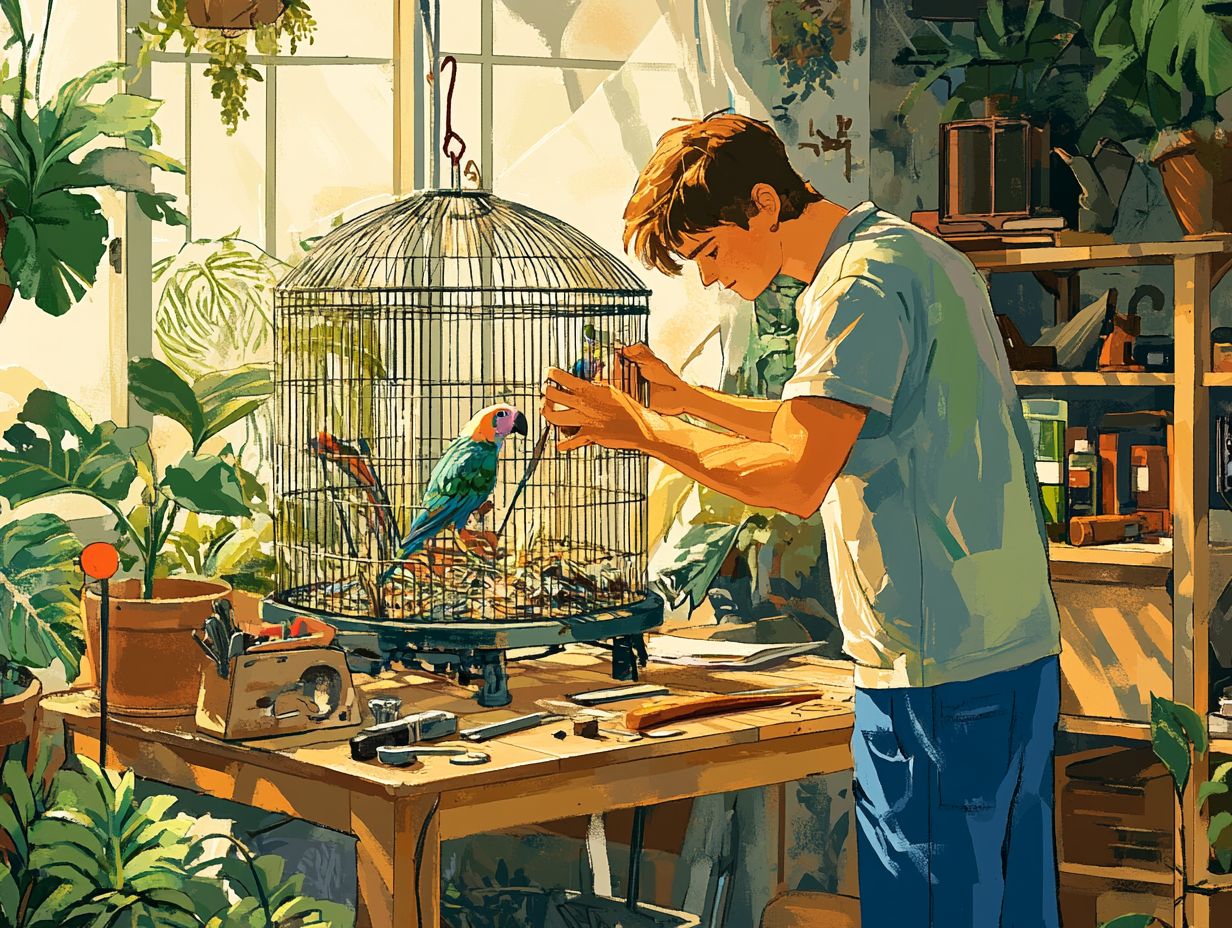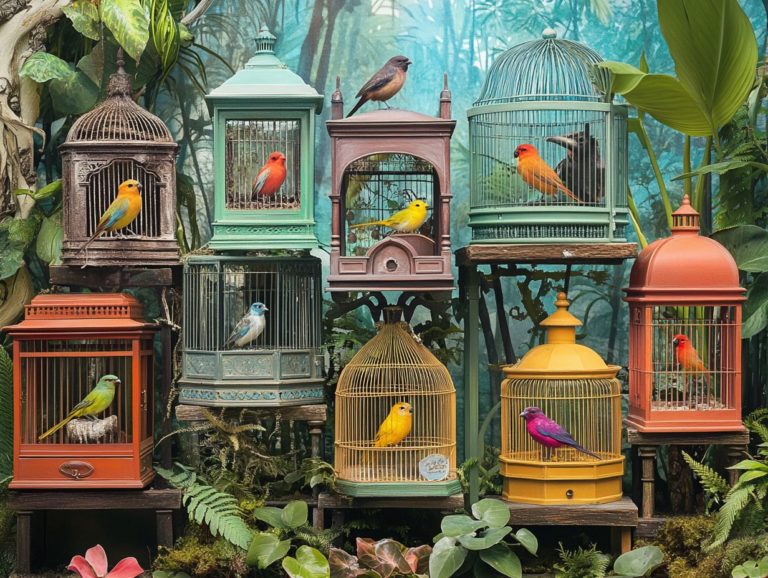How to Evaluate Cage Hazards for Birds
Creating a safe and nurturing environment for your feathered companions involves much more than simply offering a cozy cage.
Delve into the myriad hazards that can affect your birds, from harmful materials to the essential safety features that every cage must possess.
Uncover best practices for cleaning and maintaining their living space, along with expert tips for effectively bird-proofing your home.
Arm yourself with all the knowledge necessary to ensure your birds remain happy and safe!
Contents
- Key Takeaways:
- Understanding Bird Cage Hazards
- Materials to Avoid in Bird Cages
- Safety Features to Look for in a Bird Cage
- Proper Cleaning and Maintenance of Bird Cages
- Creating a Safe Environment Outside of the Cage
- Frequently Asked Questions
- 1. How do I evaluate cage hazards for birds?
- 2. What are some common cage hazards for birds and safety issues?
- 3. How can I make sure my bird’s cage is safe?
- 4. Are there any specific types of bird cages that are safer for birds?
- 5. How often should I check my bird’s cage for hazards?
- 6. What should I do if I find a hazard in my bird’s cage?
Key Takeaways:

- Choose bird cages made from non-toxic materials to avoid potential hazards and health risks for your feathered friend.
- Regularly clean and maintain bird cages to prevent the build-up of bacteria and harmful substances that can harm birds.
- Bird-proof your home to create a safe environment for your pet outside of their cage, such as covering electrical cords and keeping toxic plants out of reach.
Understanding Bird Cage Hazards
Understanding the hazards associated with bird cages is essential for the well-being of your feathered companions. These dangers can profoundly affect their health, safety, and overall happiness.
While bird cages are intended to create a secure habitat, they can inadvertently introduce various safety issues due to inadequate construction, unsafe materials, and improper bar spacing.
As a bird owner, you want to keep your pets safe. It’s important to stay alert in assessing the potential hazards in your birds environment. By implementing proper handling techniques and conducting regular physical examinations, you can safeguard against bird diseases that may emerge from these hazardous conditions.
Types of Hazards and Their Impact on Birds
Types of hazards in bird cages can range from structural issues to unsuitable materials, each presenting unique risks that could adversely affect your bird’s health.
For instance, sharp edges on poorly constructed cages can cause serious injuries, leading to cuts or lacerations on your bird’s delicate feathers and skin. Inadequate bar spacing not only opens the door for potential escapes but can also result in painful entrapment of small limbs, creating both physical harm and emotional distress for your feathered friend.
Cages made from toxic materials pose a significant threat. Fumes or ingestible substances can lead to respiratory diseases or other serious health issues. Be aware of these safety concerns to create a secure environment that promotes the overall well-being of your avian companions.
Materials to Avoid in Bird Cages
When selecting materials for bird cages, it s crucial to steer clear of options that could pose serious risks, such as zinc toxicity, often found in poorly constructed cages made from unsafe materials.
The finish of the materials plays a vital role in creating a safe environment. It’s wise to prioritize cage construction using safe alternatives like stainless steel or high-quality powder-coated finishes.
Being informed about the materials you choose for your cage is essential to prevent potential health issues stemming from toxic substances.
Commonly Used Materials and Their Risks

When considering materials for bird cages, you’ll find that metals, acrylics, and wood are commonly used, but not all of these are safe especially those that might lead to zinc toxicity.
Many bird owners may be unaware that certain metals, like galvanized steel, pose risks due to coatings that can release zinc. This zinc toxicity can cause serious health issues in birds, ranging from digestive complications to neurological problems.
On the other hand, stainless steel stands out as a superior alternative. It s durable, rust-resistant, and devoid of harmful coatings, making it a truly bird-friendly choice. Powder-coated materials can also offer an attractive finish and additional protection, but it’s essential to verify that the powders used are non-toxic and safe for your feathered friends habitats.
Choosing the right materials is vital for creating a healthy, safe environment for your avian companions. Act now to create a safe haven for your feathered friend!
Safety Features to Look for in a Bird Cage
When selecting a bird cage, it s essential to prioritize safety features that mitigate potential risks. This ensures your feathered companions have a secure and comfortable environment.
Look for vital cage features like appropriate bar spacing to prevent escapes and injuries. Robust feeder systems that are easy to clean are also important. Thoughtfully incorporating perches and toys will enhance your birds’ well-being and reduce the risk of accidents or health issues.
If you’re considering travel cages, make sure they adhere to these safety standards as well. This safeguards your birds during transport.
Important Features for Bird Safety
Key features for ensuring bird safety in cages are driven by design elements that significantly impact the well-being of your birds.
Secure locks are vital, as they help prevent accidental escapes and keep your birds safely contained. Smooth finishes on cage materials are another key consideration, eliminating the risk of injuries from sharp edges. This allows your birds to move about freely and comfortably.
Choosing the right size for the cage is equally essential. It ensures your birds have ample space to stretch their wings without feeling cramped, which can lead to unnecessary stress.
Each of these features works in harmony to create a safe environment that prioritizes the comfort and security of your feathered friends.
Proper Cleaning and Maintenance of Bird Cages
Proper cleaning and maintenance of bird cages are essential for ensuring the health of your birds and preventing the spread of avian diseases. This makes it a top priority for you as a bird owner.
Regular cleaning practices extend the lifespan of the cage and foster a hygienic environment that supports the well-being of your feathered companions.
Your effective cleaning routines should encompass:
- Sanitizing feeder systems
- Inspecting cage parts for wear and tear
- Maintaining cleanliness in areas where perches and toys reside to prevent safety concerns
Best Practices for Keeping Cages Clean and Safe

To keep bird cages clean and safe, establishing a regular cleaning schedule is essential. Choose cleaning agents that are specifically safe for birds.
By prioritizing these best practices, you can minimize the risk of harmful bacteria and mold growth, which can pose significant health threats to your birds. Consider implementing a routine that includes:
- Daily spot cleaning
- Weekly deep cleans
- Monthly thorough inspections
Don t wait start your cleaning routine today to keep your birds safe and healthy! Choosing non-toxic cleaners is crucial, as traditional chemicals can lead to respiratory issues or other health concerns for your birds.
Regularly checking for wear and tear within the cage is important. This allows you to address potential safety hazards promptly, fostering a healthy environment where your birds can thrive.
Creating a Safe Environment Outside of the Cage
Creating a secure environment outside the cage is essential for maintaining the well-being of your birds. They spend considerable time outside their enclosures.
Mastering proper bird transport techniques and being mindful of safety concerns related to handling are vital. This helps prevent accidents and avian diseases.
Ensure that the areas where your birds are permitted to roam are free of hazards. Offer safe spaces for social interaction and play. This nurtures a healthy environment and promotes the happiness of your feathered companions.
In summary, prioritizing safety features, maintaining cleanliness, and creating secure environments are crucial for your birds’ well-being. By taking these steps, you ensure a happy and healthy life for your feathered friends.
Tips for Bird-Proofing Your Home
When bird-proofing your home, the well-being of your birds is crucial. They can encounter dangers in indoor environments.
To create a secure space, start by checking your home. Begin by removing any toxic plants (such as philodendrons or poinsettias), which can pose serious health risks to your birds.
Next, think about installing screens or safe mesh for birds on windows. This helps prevent escapes and collisions, as avian species are naturally curious about their surroundings.
Don t forget to safeguard electrical cords by using protective covers or organizing them out of reach. This protects your birds and eliminates potential hazards.
Making these adjustments creates a safer home for your birds, allowing them to thrive in their indoor sanctuary.
Frequently Asked Questions
1. How do I evaluate cage hazards for birds?

To evaluate cage hazards for birds, start by carefully examining the cage and its components. You can also refer to this guide on how to evaluate your bird’s living space. Look for any sharp edges, gaps, or loose parts that could harm your bird.
Also, consider the cage material and whether it is safe for your bird to chew on. Finally, ensure that the cage placement is safe and secure.
2. What are some common cage hazards for birds and safety issues?
Some common cage hazards include sharp edges, small gaps that could trap a bird’s head or feet, toxic materials like lead or zinc, and unstable perches or toys. It is important to inspect the cage thoroughly for any potential hazards.
3. How can I make sure my bird’s cage is safe?
To ensure your bird’s cage is safe, regularly inspect and clean it. Replace any damaged or hazardous parts immediately.
Choose a cage made from non-toxic materials and ensure it is the appropriate size for your bird. Be mindful of the cage placement and any potential dangers in the surrounding area.
4. Are there any specific types of bird cages that are safer for birds?
There are a few types of cages generally considered safer for birds. These include stainless steel cages, which are durable and non-toxic, and powder-coated cages, which have a safe, non-toxic finish.
It is important to research and choose a cage that is appropriate for your bird’s size and needs.
5. How often should I check my bird’s cage for hazards?
It is recommended to check your bird’s cage for hazards at least once a week. If you notice any changes in your bird’s behavior or if it is especially active or destructive, check more frequently.
Regularly cleaning and maintaining the cage can also help prevent potential hazards.
6. What should I do if I find a hazard in my bird’s cage?
If you find a hazard in your bird’s cage, address it immediately. Remove the hazard and replace any damaged or unsafe parts.
If necessary, move the cage to a safer location. Regularly checking and maintaining the cage can help prevent hazards from occurring in the first place.






